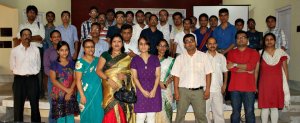
I made a short weekend trip to Guwahati, Assam (India) to attend the 10th anniversary celebrations of the Assamese Wikipedia on 10th June. Assam is known as the ‘gateway state’ to the North East of India and is home to people of diverse ethnic and linguistic origins. Including the Ahom, Bodo, Dimasa and Tai-Aiton, people of more than 10 tribes who all speak different languages inhabit Assam. However, since India’s independence and the formation of the state of Assam, Asssamese has been the official language, largely spoken by all. The Assamese language has over 1.3 crore (13 million) native speakers spread across Assam, Arunachal Pradesh, Nagaland and pockets of Bhutan. Currently, the Assamese Wikipedia has over 1000 articles and around 30 active editors. Interestingly, started in 2002, it was the first Indian language Wikipedia ever.

To mark ten years of Assamese Wikipedia, community members organized a workshop in Cotton College, Guwahati which was attended by over 60 people including students, linguists, journalists and prize winners of the article writing and photography contest. Machumi Bordoloi won the first prize for her article on “Malita” (a folk ballad) and Akashdip Goswami won the first prize for his photograph of “Kolia Bhomora Setu” – a bridge in Tezpur, Assam.
Presentations and talks explained what Wikipedia is (Gitartha Bordoloi), how one can contribute in Assamese (Bishnu Saikia), why one should contribute to Wikipedia (Uddip Talukdar), and gave lessons on community building (Jyoti Prakash Nath) and font support (by Bonojit Pathak). Their community is a perfect example of a well-knit family with one guiding another. The community’s warmth and openness to go that extra mile to welcome new members is admirable – they make sure that new users understand that editing is actually your contribution to your culture and knowledge preservation!

As a community that went from almost 0 to 30 members in a year, Assamese Wikipedians have some important lessons to offer. Jyoti, one of the most active Assamese editors, told me over dinner, “I contribute to Assamese Wikipedia so that people know about our culture and progress. Most newspapers and magazines don’t give you an objective picture of a place or its people. Wikipedia is my best bet.” I asked them how they went about getting more members. Most of them actually got acquainted on the Facebook group they run for as-wp. That’s where they asked questions, discussed and paired up for Wikiprojects. And looking at their discussions, many more were inspired.
What do they plan for the future? Get more editors, encourage the winners of photography and article contests to continue writing. The first step in this direction is the Wikiproject ‘Districts of Assam’. Writing about one’s own district, cities and towns could definitely be a great start for any new editor. They are also one of the first communities to use social media effectively for outreach. This structured way of community building that has led to the fantastic growth of the Assamese community could serve as a great example for smaller Wikipedias striving to get more editors on board. Especially for Indian language Wikipedias, a multi-pronged approach such as this (offline outreach, social media and pilot projects) might be the most sustainable way to progress.
Every little drop fills the ocean. In the Wikiverse, where many an editor has created hundreds of articles, imagine what a 30 member community could do for its Indic Wikipedia! Here’s hoping for a successful year to the Assamese community with more editors, articles and workshops!
Noopur Raval, Consultant (Communications), India Program, Wikimedia Foundation

Can you help us translate this article?
In order for this article to reach as many people as possible we would like your help. Can you translate this article to get the message out?
Start translation